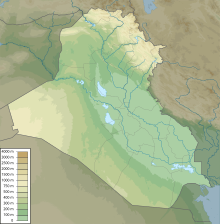| Siege of Najaf (1918) | |||||||
|---|---|---|---|---|---|---|---|
| Part of the Mesopotamian campaign of World War I and the prelude of the 1920 Iraqi Revolt[note 1] | |||||||
 Aerial view of Najaf, 1918 | |||||||
| |||||||
| Belligerents | |||||||
|
|
Jam'iya al-Nahda al-Islamiya
| ||||||
| Commanders and leaders | |||||||
|
|
Najm al-Baqqal ... and others | ||||||
| Strength | |||||||
| 1 brigade[2] | ~30,000 citizens[2] | ||||||
Location within Iraq | |||||||
The siege of Najaf was an engagement between the British Army and Iraqi rebels in the city of Najaf during the First World War. The city had fallen under the control of four sheikhs in 1915 after an anti-Ottoman uprising, and was put under British control in 1917. In 1918, as it became clear that the British were aiming to occupy rather than liberate Iraq, an anti-British movement named Jam'iya al-Nahda al-Islamiya was formed in Najaf to oppose British rule. The uprising began on 19 March when a British officer, William M. Marshall was murdered in the citadel of Najaf. The British subsequently laid siege to the city on 23 March, cutting all supply routes to the city before it ultimately surrendered on 4 May 1918. Rebel leaders were sentenced to death on 25 May. The siege is often seen as a precursor to the 1920 Iraqi Revolt. The extent of the rebellion's impact on the development of Iraqi nationalism is disputed.
- ^ Cite error: The named reference
:6was invoked but never defined (see the help page). - ^ a b Rutledge, Ian (2015-06-01). "Chapter 15 - Najaf 1918: First Uprising on the Euphrates". Enemy on the Euphrates: The Battle for Iraq, 1914 - 1921. Saqi. ISBN 9780863567674.
Cite error: There are <ref group=note> tags on this page, but the references will not show without a {{reflist|group=note}} template (see the help page).
